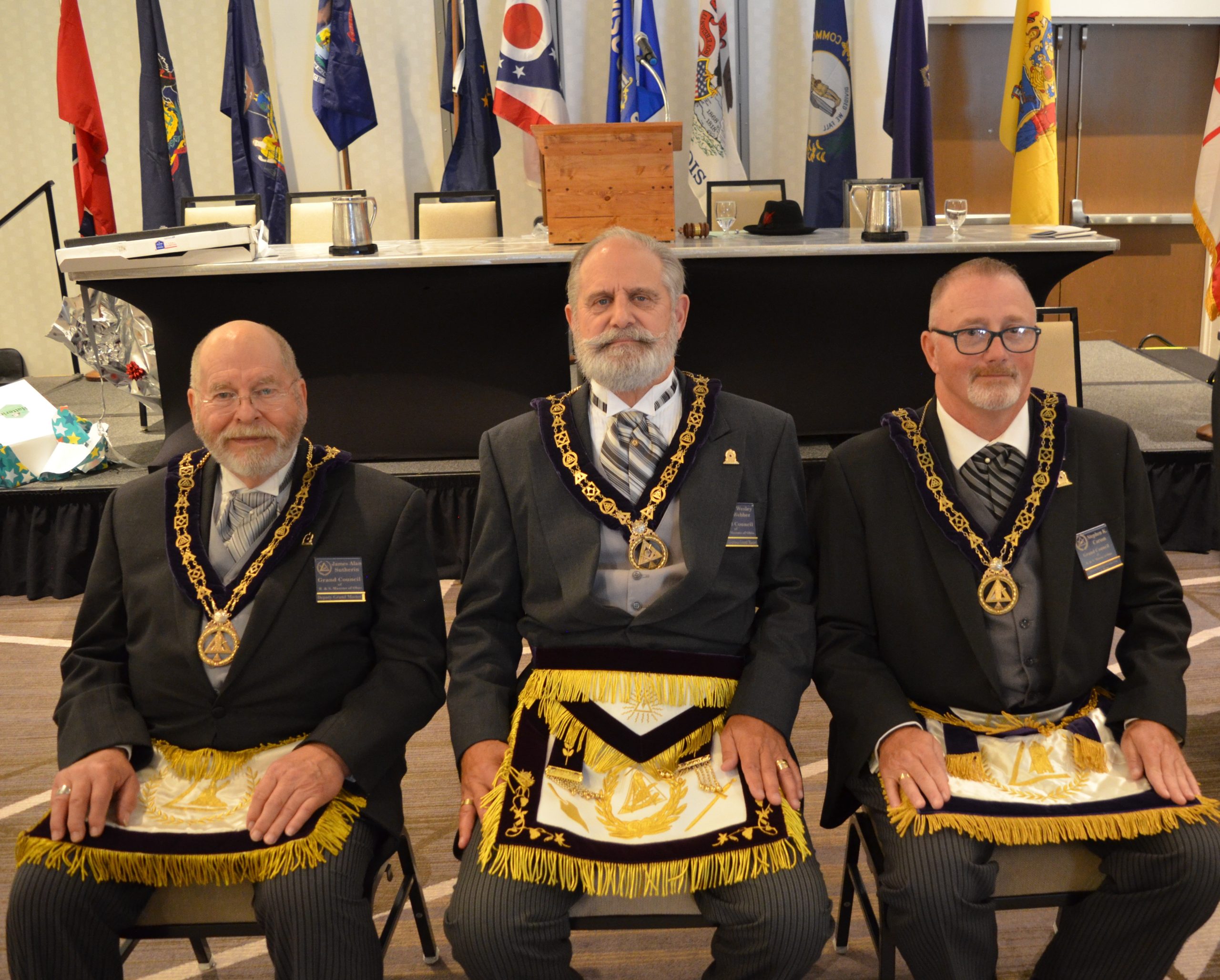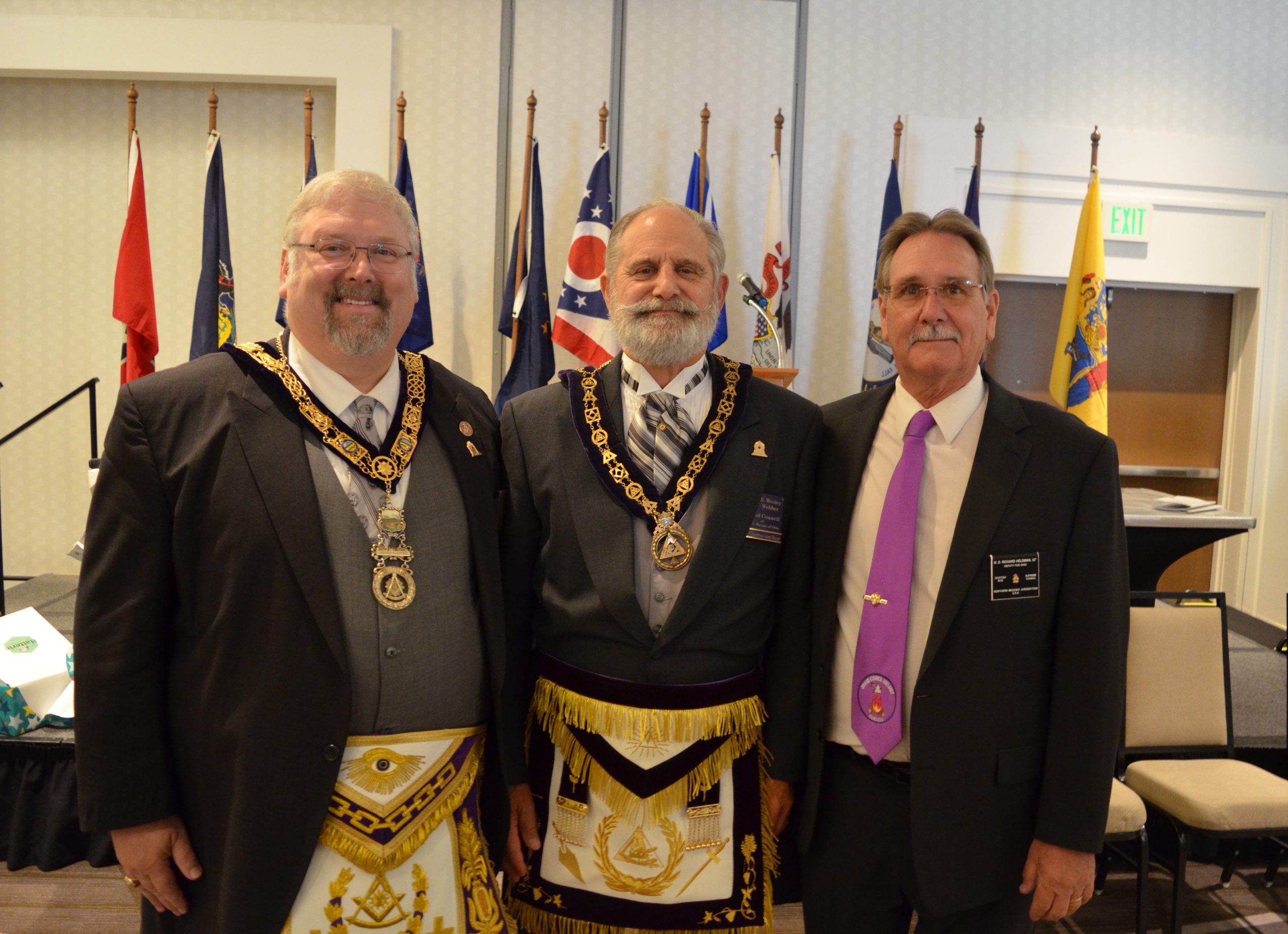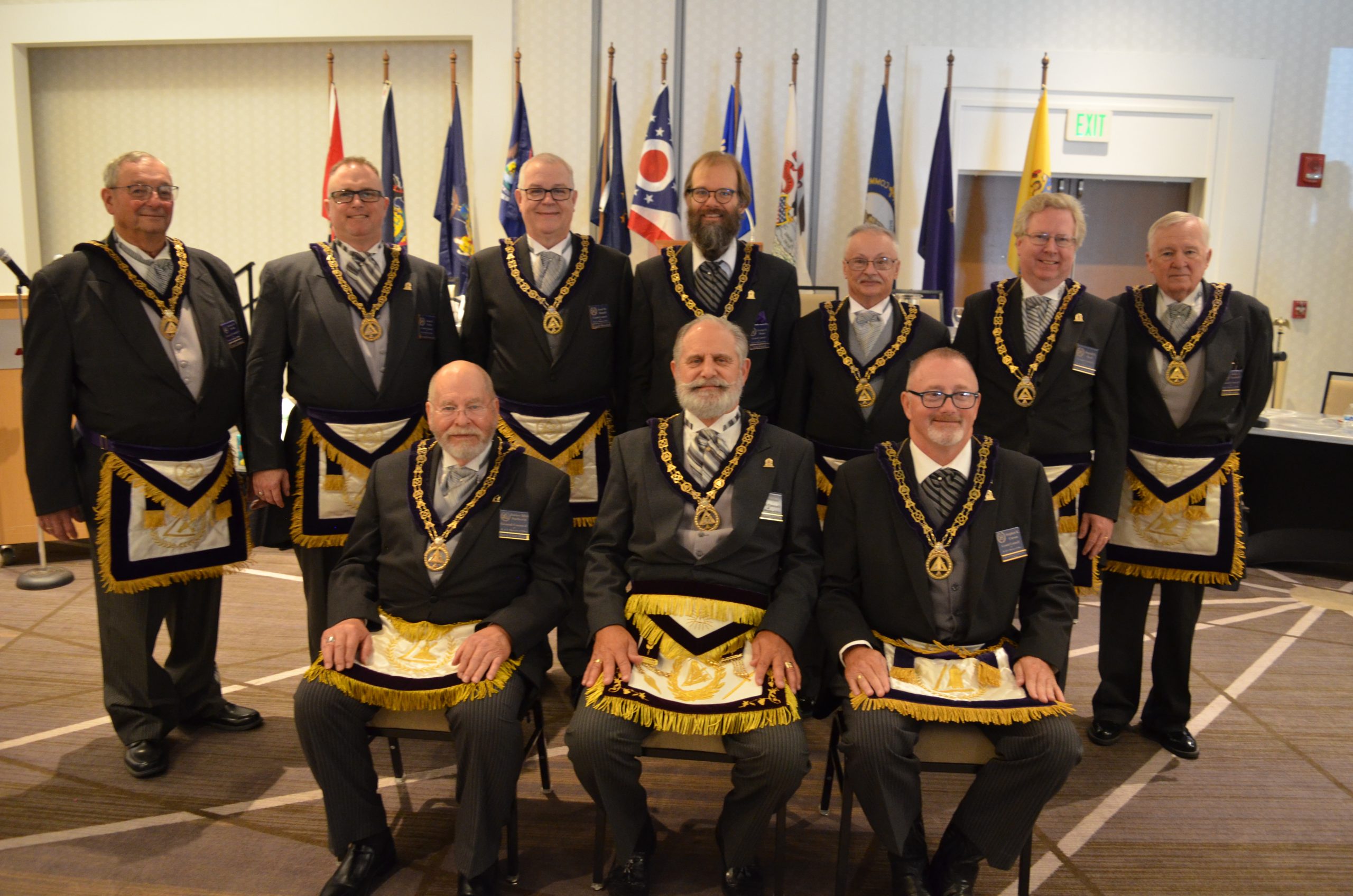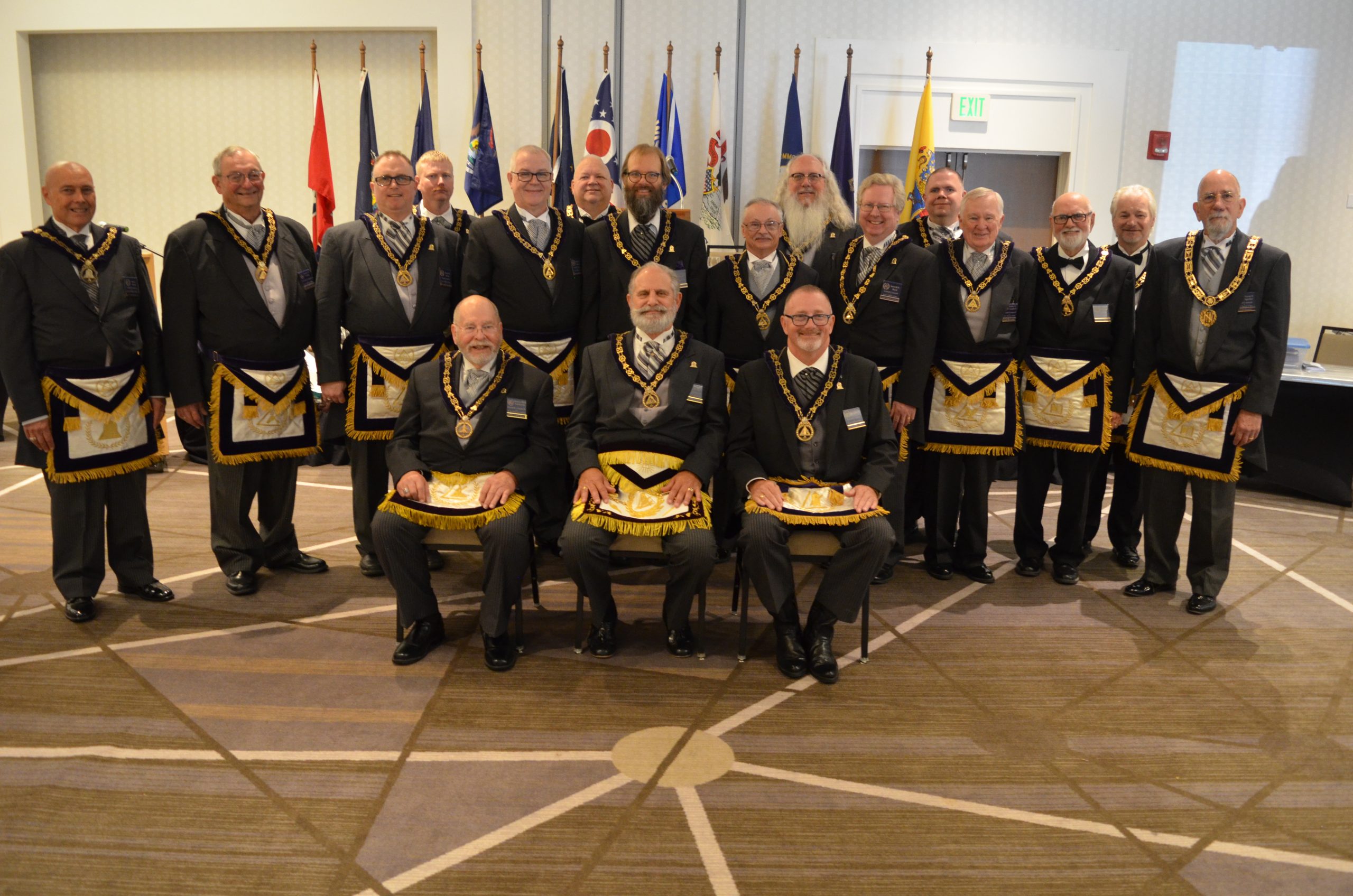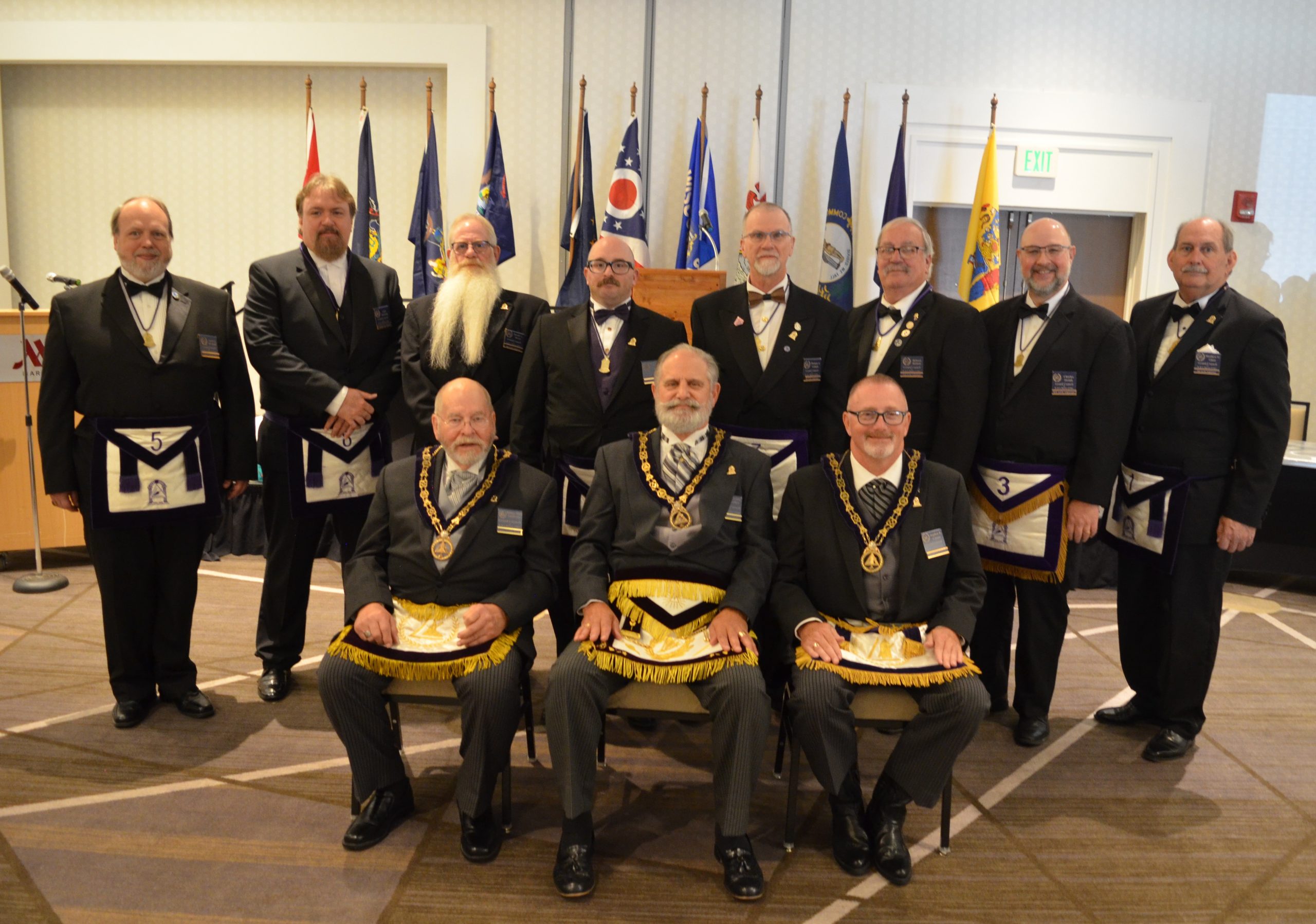Origin of Names of Third Arch Councils
By Norman G. Lincoln PM
Cincinnati Council No. 1 Chartered Oct. 24, 1827 in Cincinnati, Hamilton County
The first White Man to explore the land area of the Third Arch was Christopher Gist who penetrated as far as Piqua as a surveyor for the Ohio Company in 1751. Fort Finney was built at the mouth of the Great Miami River in 1785. George Rogers Clark, Richard Butler and Samuel Parsons, all Masons, made a treaty with the Indians in 1786. In 1788 John Cleves Symmes, a member of Trenton Lodge No. 5 NJ, obtained one million acres of land from the US government. [Symmes believed the earth was hollow] Matthias Denman, Robert Patterson and John Filson bought and surveyed land in that same year. Filson called the settlement Losantiville meaning the town across from the mouth of the Licking River. After Filson was killed by Indians in 1789, Israel Ludlow took his place. In 1790 Arthur St. Clair, a petitioner for N.C. Harmony Lodge #2, renamed the village Cincinnati because he was a member of the Society of Cincinnati. This was an organization composed of officers who had fought in the Revolution. It was named after Lucius Titus Quinctius Cincinnatus who left his farm in 458 BC to defend Rome against the Aequi and the Volsians. It was said of him: “Omnia relinquit servare republicanum”.
[He gave up all to serve the republic] Cincinnati was chartered a village in 1802 and incorporated a city in 1819. Longfellow called it the Queen City. Its population is 331,000. Also in 1790 Josiah Harmar, [made a Mason in Lodge No. 3 Philadelphia] failed to defeat the Indians; and Hamilton County named after Alexander Hamilton [not a Mason] was organized.
Reese Council No. 9 Chartered Oct. 24, 1843 in Dayton, Montgomery County
Richard Montgomery was born in Ireland Dec. 2, 1736. He enlisted in the 17th Infantry Regt. and was raised in its traveling lodge. He helped Bro. James Wolfe capture Quebec. In 1772 he resigned his commission and moved to New York. He married Bro. Robert Livingston’s daughter and led the army which was unable to capture Quebec where he was killed in the unsuccessful assault. The first settler in Montgomery County, which was organized in 1803, was Zachariah Hole who moved there in 1797 and built a tavern. Elias Dayton (1737-1807) was a General in the Revolution and a member of military lodge # 19 PA. He was a member of the Society of Cincinnati. His son Jonathan (1760-1824) also fought in the Revolution, helped write the Constitution and served in Congress. He also bought land from Symmes but did not move to Ohio. He was a member of Temple Lodge # 1 NJ. The city of Dayton was incorporated in 1803. It is called the Gem City and its population is 166,000. William James Reese was born in Philadelphia Aug. 3, 1804. He studied law and moved to Lancaster where he edited the Gazette and married Elizabeth Sherman daughter of Grand Master Charles Sherman. Reese was Grand Master from 1834 to 1843. He was also Grand High Priest 1832 and 1836 to 1838 and Grand Illustrious Master 1834 to 1838. He advanced to Grand Generalissimo of the Grand Encampment of Knights Templar. In 1843 his dry goods business failed and he returned to Philadelphia. In 1857 he suffered a stroke and was an invalid until his death in Lancaster Dec. 16, 1883.
Hillsboro Council No. 16 Chartered Oct. 1, 1850 in Hillsboro, Highland County
The first settler in Highland County, which was named after the high ground between the Little Miami and the Scioto Rivers, was Joseph Van Meter who arrived near what is now Lynchburg in 1797. John Gossett built a gristmill at New Market in 1799. George Barrere settled there in 1801. His son John was an active York Rite Mason. The county was organized in 1805. [The Highlands of Scotland are famous in song and story] Hillsboro was named the county seat in 1807. Anyone who’s been there knows why it received its name! The population is 6,300.
Springfield Council No. 17 Chartered Oct 22, 1852 in Springfield, Clark County
Clark County was the hunting grounds of the Shawnee Indians. In 1751 Christopher Gist discovered the Mad River. In August 1780 General George Rogers Clark [a Mason] attacked and routed the Indians from Piqua Town. Simon Kenton 1755-1836 was his guide. Twelve year old Tecumseh [said to have been a Mason by the Canadians] watched. David Lowry 1767-1859 and Jonathan Donnel built homes west of Mad River in 1795. Kenton [possibly a Mason] built a fort in 1799 at the fork of Buck Creek and Mad River. Two years later James Demint laid out a town he called Springfield at the suggestion of his wife. Clark County was organized in 1817. Springfield became the county seat and grew to 65,000.
Hamilton Council No. 19 Chartered Nov. 20, 1854 in Hamilton, Butler County
General Richard Butler was born April 1, 1743 in Dublin, Ireland. He came to America in 1760. He commanded the right wing in St. Clair’s ill-fated expedition against the Indians and was killed Nov. 4, 1791. Raised in Lodge No. 2, Philadelphia April 27, 1779. He was previously stationed at Fort Hamilton in Butler County. Israel Ludlow [born in NJ 1765] was appointed to survey Symmes’ Purchase in 1787. When Fort Hamilton was abandoned, he purchased land on which it stood. In 1794 he laid out the town of Fairfield which later was named Hamilton. Ludlow died in 1804. Hamilton was incorporated in 1810 and now has 61,000 population. The first mayor and first sheriff of Butler County was James McBride. Butler County was organized in 1803.
Kilwinning Council No. 52 existed from 1867 to 1894 in Cincinnati. Its name is derived from a town in Scotland where an Abbey was built in 1140 to St. Winnin. Legend ascribes this as the beginning of Freemasonry in Scotland. No proof exists.
Wyoming Council No. 77 existed from 1893 to 1907 in the Cincinnati suburb. The name supposedly derives from a Delaware Indian word “Maugwauwama” meaning large plains. Indians massacred 400 settlers in the Wyoming Valley of PA in 1778.
Wright Council No. 96 Chartered October 2, 1906 in Xenia, Greene County
George and Amos Wilson settled along Mill Creek in what became Greene County in 1796. Nathaniel Greene was born in Rhode Island June 6, 1742. He fought at Trenton in 1776 and defeated the British in the South in 1781. He is considered a Mason but his lodge is unknown. He died June 19, 1786 at Savannah, GA. Xenia was founded by John Paul who bought 2000 acres of land in Greene County in 1803 the year it was organized. Joseph C. Vance surveyed the site in 1803 and Rev. Robert Armstrong suggested the name which in Greek means hospitality. Xenia was incorporated in 1817 and became a city in 1834. It has a population of 24,000. Lewis Wright was born in Brunswick County VA Feb. 11, 1796. He moved to Ohio when he was 19. He was raised in Xenia Lodge No. 49 Sept. 15, 1847 and served as WM in 1859. He joined Xenia Chapter No. 36 on Nov 11, 1848 and served as Excellent High Priest from 1850 until his death. He was a member of Reese Council No. 9 and a Methodist. He died Nov. 8, 1866. Wright Council No. 53 was chartered in 1867 but went dark in 1888.
Blanchester Council No. 114 Chartered Oct. 2, 1917 in Blanchester, Clinton County
Wilmington Council No. 116 Chartered Oct. 2, 1917 in Wilmington, Clinton County
Clinton County was named after George Clinton who was Vice-President when it was formed in 1810. He was born July 26, 1739 in NY. An uncle of DeWitt Clinton, he was in the Revolution and was Governor of New York. He was a member of Warren Lodge No. 17 NY. He died April 20, 1812. The county was surveyed by Maj. John O’Bannon and Arthur Fox in 1787. The first settler appears to be Morgan Van Meter who erected a tavern in Green Township in 1799. The county seat had three names: in 1810 Clinton, then Armenia and Mt. Pleasant. Eventually it was named Wilmington in 1811. The first settler was Joseph Doan who arrived in 1805. Isaiah Morris erected a tavern in 1810. The Ist Earl of Wilmington, Spencer Compton 1673-1743, was a friend of King George II who named him Prime Minister in 1743. The Earl, who served in Parliament for 45 years, had made his friend Gabriel Johnston Governor of North Carolina. Compton was also a friend of William Penn. Thus cities in NC and DE became known as Wilmington. The Ohio city has a population of 11,900. Blanchester was first settled in 1814 by Jonathan Baldwin who bought land from General William Lytle who surveyed it. Joseph Blanchet opened a grocery store in 1832 shortly before the village was organized. Blanchester is likely named after him. The literal meaning is white/clean town/camp. Population 4,200.
Adoniram Council No. 131 Chartered Feb. 1, 1943 in Miamisburg, Montgomery County
See Reese # 9 for Montgomery County. The first settler in the Miamisburg area was Zachariah Hole in 1797. The city was laid out in 1818 by Emmanuel Gebhart, Jacob Kercher, Dr. John Treon and Dr. Peter Treon. It was named after the Indian tribe which once lived in the area. The population in 2000 was 19,489. Adoniram is a character in Masonic ritual taken from scripture where he was the tax collector for David and Solomon.
Lebanon Council No. 134 Chartered Oct. 10, 1951 in Lebanon, Warren County
The earliest settler in Warren County was William Bedle who came from NJ in 1795. Next came the Corwin brothers, Ichabod b. 1768, Joseph b. 1771 and Matthias b. 1761. They settled near Turtle Creek and erected the Black Horse Tavern. Matthias’ son was
Thomas Corwin Governor of Ohio and Grand Master of the Grand Lodge. [Joseph was this writer’s great great great great grandfather] Warren County was organized in 1803 and named after Dr. Joseph Warren 1741-1775 who died at Bunker Hill. Raised in St. Andrews Lodge, he was Provincial Grand Master for Scotland. The city of Lebanon was organized in 1802 and named after the mountain range in Syria where cedar trees for the building of Solomon’s Temple were cut. The early settlers thought that juniper trees were cedar trees. There are no mountains in Warren County. Lebanon has a population of 17,000. Lebanon Council No. 21 existed from 1855 to 1891.
Preble Council No. 135 Chartered Oct. 7, 1953 in Eaton, Preble County
Fort St. Clair was built west of Seven Mile Creek early in 1792. In November Indians under Little Turtle attacked soldiers led by Major John Adair [later with Jackson at the Battle of New Orleans and a Governor of Kentucky]. Two soldiers and six Indians were killed. In 1806 William Bruce laid out Eaton and constructed a gristmill. The village was named for William Eaton [b. Feb. 23, 1764 in Woodstock CT] who was consul to Tunis and let a motley army and some Marines “to the shores of Tripoli”. He was a member of North Star Lodge, Manchester VT. He died June 1, 1811. Eaton Council No. 6 existed from 1840 to 1858. Eaton’s population is about 8,000. Preble County was organized in 1808 and named for Commodore Edward Preble [b. Aug. 15, 1861 Portland ME d. Aug. 25, 1807]. He commanded the American squadron which fought against the Barbary pirates. He was initiated in St. Andrews Lodge, Boston in 1783.
Middletown Council No. 136 Chartered Oct. 7, 1953 in Middletown, Butler County
For Butler County see Hamilton Council # 19. The first settler near Middletown was Daniel Doty who was born in NJ in 1765. He settled on the bank of the Great Miami a mile south of Middletown in 1796. Stephen Vail, a Quaker from NJ, laid out the town plat in 1802 and built a log cabin. The name may have been selected by Vail because that was his birthplace in NJ or because it was halfway between Cincinnati and Dayton. Middletown was incorporated in 1833. Paper and steel contributed to its growth to a population of 51,600.
Henry A. Weeks Council No. 137 Chartered Oct 11, 1954 in Norwood, Hamilton Co.
For Hamilton County see Cincinnati Council # 1. As Cincinnati grew, so did its suburbs. One of these was Sharpsburg named after John Sharp where a tavern was built on the Montgomery Pike as early as 1809. This name did not seem fitting and in 1869 it was changed to Norwood at the suggestion of Sarah Bolles. [Another possible source was the novel by Henry Ward Beecher] At any event the village grew into ‘the gem of the highlands’ to be entirely surrounded by Cincinnati. [A false claim has made this is the only such city completely within another] In 1888 John Uri Lloyd 1849-1936 the famous pharmacist platted the streets. Norwood became ‘the city that industry built’ , notably Fisher Body and US Playing Cards together with United Dairy Farms and Shott Buick.
The population today is 24,000. Henry Abraham Weeks was born April 28, 1861 in Cherry Valley, Ontario, Canada. He taught for nine years and came to Cincinnati in 1886 as a bookkeeper. He moved from job to job and city to city always progressing in his chosen field of endeavor. He was married twice to Mary Scott and Emma Fowler and belonged to the Presbyterian Church. He was raised in East Liverpool Lodge # 315 May 26, 1899 and served as WM of Pleasant Ridge Lodge # 282 in 1910. He joined East Liverpool Chapter # 100 April 24, 1900 and was EHP of McMillan Chapter # 19 in 1910. He then became a charter member of Acacia # 195 in 1914. He joined Madison Council # 36, Madison IN Nov. 21, 1904 and served as TIM of Cincinnati # 1 in 1910. He joined Madison Commandery # 22 IN Feb. 23, 1906 and served as EC of Trinity # 44 in 1910. He was GM of the Grand Council in 1923 and died Dec. 7, 1925.
Silver Trowel Council No. 141 Chartered Oct 12, 1955 in Dayton, Montgomery Co.
See Reese Council # 9 for Dayton and Montgomery County.
The trowel is an tool made use of by operative masons. It is an emblem important to Cryptic Masons along with the sword. The symbolism derives from scripture and is familiar to all Council members
New Carlisle Council No. 143 Chartered Oct. 21, 1958 in New Carlisle, Clark County
For Clark County see Springfield # 19. New Carlisle is in Bethel Township on the banks of Honey Creek near where Clark defeated the Indians in 1780. John Paul 1763-1853 was the first settler in 1790. The village was laid out by William Reyburn in 1810 and called York. It was later changed to Monroe, Pierceville and finally to New Carlisle in 1828.
Carlisle, England, was a Roman outpost near Hadrian’s Wall. The Latin name was Luguvallum but its British name was Caer Luel. The population is 5735.
John H. Campbell Council No. 147 Chartered Oct. 4, 1966 in Amelia, Clermont County
The father of Clermont County was William Lytle who was born in Fayette County KY in 1770. He became a famous Indian fighter and surveyor and in 1796 platted a village on the East bank of the Little Miami River which was called Lytlestown. When the county was established in 1800 [the name mean clear mountains and plains in French] the name was changed to Williamsburgh. It became the original county seat and lost the final “h”. Lytle move to Cincinnati in 1809; and in 1830 a year before his death was appointed Surveyor General by his friend President Andrew Jackson. His name lives on in Lytle Park and Lytle Tunnel. John Henry Campbell was born Aug. 25, 1879 at Locust Ridge, Brown County OH. He taught school and became a rural mail carrier. In 1901 he married Edna Beacham of Williamsburg. He was raised in Clermont Social Lodge No. 29 Oct. 9, 1908 and served as WM in 1913 1914 1nd 1919. He was also Secretary for 32 years. He joined Batavia Chapter No. 112 July 12, 1943 and served as EHP in 1952. He was a member of the Methodist Church. Strangely enough he was not a Council member. He
died June 22, 1963. His son Calvin was a charter member of the Council named for his father. The Council first met in Williamsburg and moved to its present location in 1987. Amelia was originally named Mill Town. It had been surveyed by John O’Bannon in 1788. Mill Town was shortened to Milton and then changed to Amelia to honor Armillous “Amelia” Bowdoin operator of the Ohio Turnpike toll gate. Incorporated in 1900 it has a population of 2752.
Oak Hills Council No. 148 met from 1968 to 1973 in Cincinnati.
Hubert O. Auburn Council No. 149 Chartered Oct. 6, 1980 in Cincinnati, Hamilton Co.
This Council meets on West Fork Road. See Cincinnati # 1 for city and county details.
Hubert O. Auburn was born Sept. 18, 1907 in Cincinnati. He graduated from Mt. Healthy High School and earned a B.S. in Journalism from Ohio State University where he was the managing editor of “the Lantern”. He then went to work for the Tenacity Mfg. Co. in Lockland eventually becoming its president. He was raised in McMakin Lodge No. 120 Apr. 20, 1929 and served as WM in 1938. He joined Cumminsville Chapter No. 158 Apr. 28, 1933 and served as EHP in 1940. He joined Cincinnati Council No. 1 Apr. 11, 1941 and served as TIM in 1948. He was knighted in Cincinnati Commandery No. 3 Feb. 26, 1945 and served as EC in 1951. He was Eminent Prior of Ohio Priory No. 18 Knights of the York Cross of Honor in 1961 and Grand Master of the Grand Council in 1965. He was also a member of the Scottish Rite and St. Columba Conclave Red Cross of Constantine where he was Illustrious Sovereign in 1960.
Works Consulted:
Dates Chartered-Roster of Grand Council 2004
Extinct Councils-Proceedings of Grand Council 2004
History of Hamilton, Montgomery, Highland, Clark, Butler, Greene, Clinton, Warren, Preble and Clermont Counties.
History of Grand Council 1930 for Henry A. Weeks
History of Grand Council 1980 for Hubert O. Auburn
Proceedings of Grand Chapter 1867 for Lewis Wright
Paper by Pat King Ohio Chapter of Research 1980 for William J. Reese
Typescript biography of John H. Campbell by Robert Prewitt [Courtesy of Bobby Campbell]
Article by Norman G. Lincoln Knight Templar 1979 for William Eaton
10,000 Famous Freemasons for Clark, Butler, Greene, Clinton, Warren, and Preble
General Richard Montgomery and the American Revolution 1994 by Hal T. Shelton
Funk and Wagnalls New Standard Encyclopedia
Websters New Collegiate Dictionary
History of the Grand Lodge of Ohio 1912
History of the Grand Chapter of Ohio 1966
Internet articles on biography and history
Coil’s Encyclopedia
Mackey’s Encyclopedia

